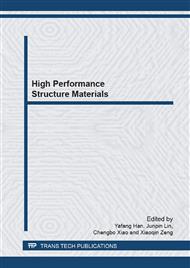p.1
p.9
p.14
p.19
p.25
p.31
p.38
p.44
The Effect of Stoichiometry and Degree of Order on Mechanical Properties of Ni3Fe Intermetallics
Abstract:
The effects of Fe stoichiometry and degree of order on mechanical properties of intermetallics Ni3Fe were investigated. The experimental results showed that the phase composition and the grain size of Ni3Fe alloy was independent on Fe stoichiometry. The Ni3Fe alloy with the normal stoichiometry had the lowest elongation in the ordered and disordered alloys. The tensile strength of Ni3Fe alloy depended on Fe stoichiometry of alloy. The effect of Fe stoichiometry on the mechanical properties of the ordered alloy was larger than that of disordered alloy. There were more point defects in lattice when the alloy stoichiometry deviating from the normal stoichiometry in the Ni3Fe alloy. The changes of the concentration of the point defects and degree of order altered the deformation behavior of the Ni3Fe alloy.
Info:
Periodical:
Pages:
19-24
Citation:
Online since:
February 2013
Authors:
Price:
Сopyright:
© 2013 Trans Tech Publications Ltd. All Rights Reserved
Share:
Citation:


